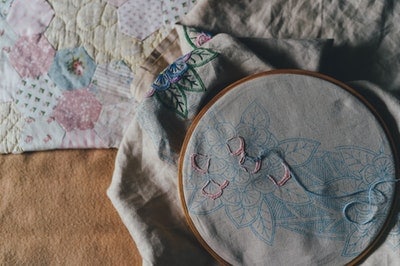
Sew Fun! 5 Embroidery Stitches Every Beginner Needs to Know
Did you know that picking up a new hobby can improve your mental health? Embroidery can be great for working on fine motor skills as well as patience and precision.
Once you’ve learned the running stitch to make a dotted line and the backstitch to make a solid line, you can move on to the other basic stitches. Below are some of the more popular and useful embroidery stitches for beginners.
1. Stem Stitch Embroidery
What is the stem stitch and what does it look like? This popular embroidery flourish creates a thick and sturdy straight line that is perfect for stems, stalks, and more. Hence its name, the stem stitch.
This stitch is achieved by stitching forward as if you are making a straight stitch. Then, bring the needle up through the bottom of the fabric to the side of your stitch. Use high-quality thread to give your stems bold colors and make them stand out.
2. Satin Stitch Embroidery
The satin stitch is much different from the stem, straight, running, and backstitch. It is used to fill in or shade in areas of your embroidery with a smooth swath of color.
This stitch is simple enough to execute, which makes it perfect for beginners who want to add texture and color to their portraits.
To pull off a satin stitch, be sure to start with the shape outlined that you’d like to fill. Then, start at one end with the needle and cross the gap, extending the thread across the middle of your shape. Continue in this way, stringing threads close together to create a full shaded area.
3. Blanket Stitch Embroidery
The blanket stitch is used for just that, blankets. It is one of the trickier beginner stitches to master, but can be learned with a little practice. Practicing tricky stitches can be great for improving fine motor skills.
This stitch is often performed at the edge of a blanket and involves looping the thread so that it catches itself and pulls taut.
4. Straight Stitch Embroidery
The straight stitch is one of the most basic there is, and it requires little explanation. It also requires little practice to truly master, making it a basis for many other stitches.
The straight stitch is a basic up and down stitch. Bring the thread through the bottom, extend it some distance, then bring it back down through the fabric to create a straight segment.
5. French Knots Embroidery
French knots are named because of their appearance as small knots on your embroidery. They provide texture and can be used to create dots or any spherical adornments.
To create this shape, start by flossing through the bottom of the fabric. Then wrap the excess thread around the needle twice, creating a firm bond. Bring the needle back down through the fabric close to where it came through initially.
You can adjust the size of the French knots by wrapping the thread around the needle less or more times.
Beginner Embroidery Stitches For Any Project
Whether you’re just starting out or are picking up embroidery again for the first time in a while, here are the key beginner stitches and knots to know.
Browse our embroidery products today, in vast quantities and high quality. From machines to thread and accessories, we’ve got it all.


